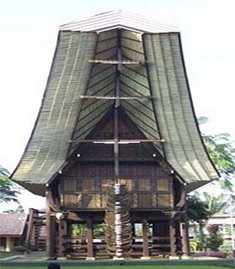
Padang (means field) is the capital and largest city of West Sumatra, Indonesia. It is located on the western coast of Sumatra at 0°57′0″S, 100°21′11″E. It has an area of 694.96 square kilometres (268.3 sq mi) and a population of over 750,000 people, mostly speakers of the Minangkabau language.

History
Padang circa 1795
Since the 16th century Padang has been a trade centre. During the 16th and 17th centuries pepper was cultivated and traded with India, Portugal, the United Kingdom and the Netherlands. In 1663 the city came under the authority of the Dutch. The Dutch built a trading post here in 1680. The city came under British authority twice, the first time during the war between the United Kingdom and the Netherlands (1781-1784) and again when the United Kingdom managed the area for the Netherlands during the Napoleonic wars (1795-1815). Afterwards the city was transferred back to the Netherlands. Up to approximately 1780 the most important trade product was gold, originating from the gold mines in the region. When the mines where exhausted, the emphasis turned to other products such as coffee, salts and textiles.
At the time of independence the city had 50,000 or so inhabitants. Coffee was still inportant, but copra was also a major item produced by farmers in its hinterland. The population growth since then has been partly a result of growth in the area of the city, but largely is a result of the migration to major cities seen in so many developing nations.
In 1950 there had also been a development of the Ombilin coal field with Padang as its outlet. This is an indication of the colonization of Indonesia having been economic as well as political.
Besides locally grown coffee and copra, Padang was a key point in the trade of such items as rubber, tea, spices, cinchona bark, resin, tobacco and rattan.[1]
Administration
Padang is divided in 11 subdistricts (kecamatan): Bungus Teluk Kabung, Koto Tangah, Kuranji, Lubuk Begalung, Lubuk Kilangan, Nanggalo, Padang Barat, Padang Selatan, Padang Timur, Padang Utara, Pauh
Transport
The city is served by the newly-opened Minangkabau International Airport in Ketaping, Padang Pariaman. Padang's Teluk Bayur harbor is the largest and busiest harbor on the west coast of Sumatra.
Education
Andalas University is the oldest university in Indonesia outside of Java. It is located in Limau Manis, about 12 kilometres (7 mi) from the center of Padang. The other universities in Padang are Universitas Negeri Padang in Air Tawar, Bung Hatta University in Ulak Karang, Baiturrahmah University in Air Pacah, Universitas Putra Indonesia YPTK, Ekasakti University, Universitas Muhammadiyah Sumatera Barat and Tamansiswa University.
Culture
Cuisine
The cuisine of the Minangkabau people is commonly called Padang cuisine, due to it being the capital and largest city of the region. Padang restaurants are common throughout the country and are famous for their spicy food and their unique way of serving it. Padang food is served in small portions of various dishes, in a way similar to tapas or mezedes, but constituting, with rice, a complete meal. In a Padang-style restaurant, the table will quickly be set with dozens of small dishes filled with highly-flavored foods such as curried fish, fried tempeh, stewed greens, chili eggplant, curried beef liver, fried chicken, and of course, sambals, the spicy sauces ubiquitous at Indonesian tables. Customers take - and pay for - only what they want from this array of dishes. The best known Padang dish is rendang, a spicy meat stew. Soto Padang (crispy beef in spicy soup) is local residents' breakfast favorite, meanwhile Sate (beef satay in curry sauce served with ketupat) is a treat in the evening.
Sport
Padang is the home town of the soccer team Semen Padang, with Haji Agus Salim Stadium being the home stadium of the club.

Tourism
Padang is a common transit point for surfers travelling to Batu Islands and Mentawai Islands, and for tourists visiting the West Sumatran highlands. Padang beach (known as Taplau or Tapi Lauik) which located from Samudra Street until Puruih, is well-known for its beautiful sunset and hundreds of food stalls. Bungus bay, to the south of Padang, is suitable for swimming and boating.
Adityawarman Museum specializes in the history and culture of the local Minangkabau ethic group, and the main exhibits are housed within a Rumah Gadang style building.

Tidak ada komentar:
Posting Komentar